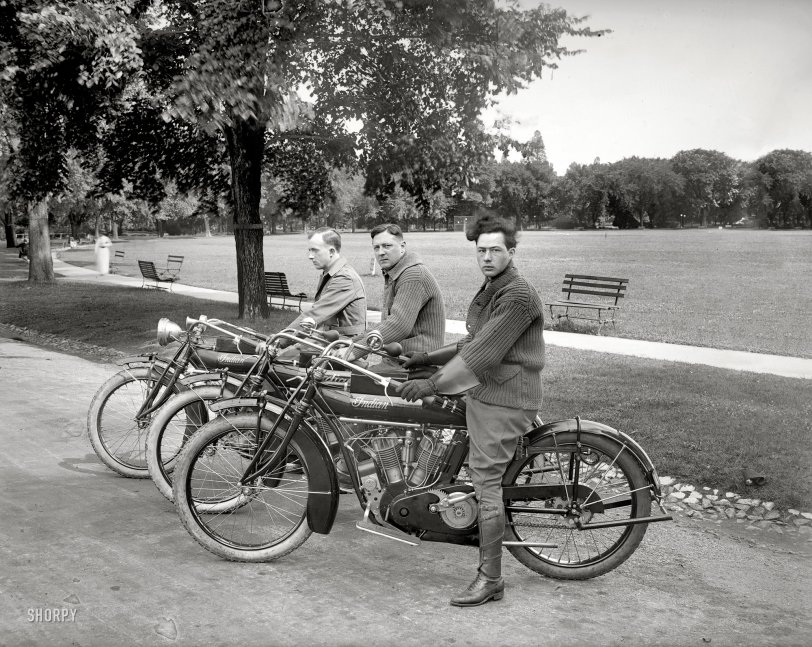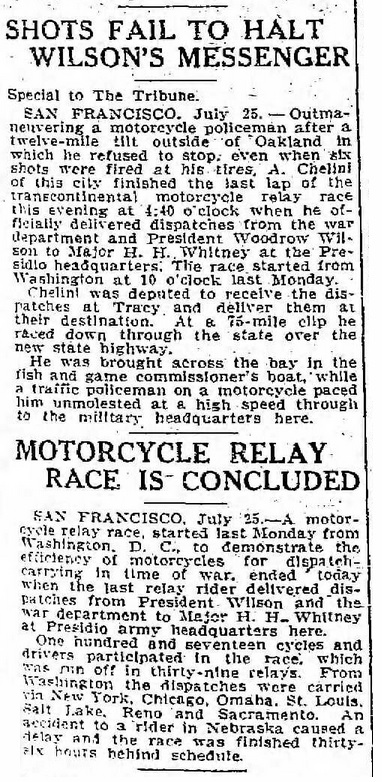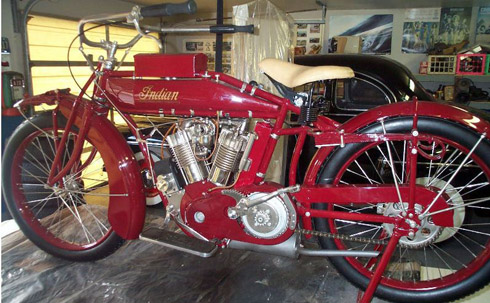


Framed or unframed, desk size to sofa size, printed by us in Arizona and Alabama since 2007. Explore now.
Shorpy is funded by you. Patreon contributors get an ad-free experience.
Learn more.

- Texas Flyer wanted
- Just a Year Too Soon
- WWII -- Replacing men with women at the railroad crossing.
- Yes, Icing
- You kids drive me nuts!
- NOT An Easy Job
- I wonder
- Just add window boxes
- Icing Platform?
- Indiana Harbor Belt abides
- Freezing haze
- Corrections (for those who care)
- C&NW at Nelson
- Fallen Flags
- A dangerous job made worse
- Water Stop
- Passenger trains have right of way over freights?
- Coal
- Never ceases to amaze me.
- Still chuggin' (in model form)
- Great shot
- Westerly Breeze
- For the men, a trapeze
- Tickled
- Sense of loneliness ...
- 2 cents
- Charm City
- What an Outrage
- Brighton Park
- Catenary Supports
Print Emporium
Three Indians: 1915

Washington, D.C., July 1915. "Motorcycle team, relay to Frisco." Frank S. Long, F.L. Leishear (whose Indian store we saw here) and Josiah McL. Seabrook. National Photo Company Collection glass negative. View full size.
Unpunctual
The messages were delivered 36 hours late according to the article below from The Salt Lake Tribune from July 26, 1915. Research indicates that the riders were trying to show that taking a dispatch on a motorcycle across the country would be faster than placing the same message on a train. As originally scheduled, the race would have gone through Sacramento during the national Federation of American Motorcyclists (FAM) convention in Sacramento, but this did not happen because of the belated arrival of the dispatch rider. The FAM was the organization behind the race. All riders were asked to conduct a rehearsal ride on July 11th.
The purpose of riding in teams of three was to ensure that if something happened to the primary rider or his motorcycle another rider would be immediately available to continue the mission to San Francisco. Of the three riders pictured here, Seabrook punctured a tire before reaching Baltimore, and he dropped out; Long ran into a pile of rocks in Baltimore, and he was injured; so Leishear became the only man to make it to the first transfer point.
By Bryan, Ohio, near the Indiana border, the racers were five and a half hours late because of rains and bad roads. By the time the riders reached Chicago they were 12 hours behind schedule. Some time was made up on the way to Moline, Illinois as the deficit was reduced to just eight and a half hours upon arriving there, and seven hours at Des Moines, Iowa. In Nebraska the lead rider had an accident, but the other riders were far behind him. Consequently, by Rock Springs, Wyoming the riders were 19 hours behind their scheduled arrival, and at Ogden, Utah 18 hours overdue. I did not find where the other 18 hours were lost, but many sources mention the 36 hour late arrival.
The official route, dates, and times as originally scheduled were shown in the Ogden Standard (Ogden, Utah) on July 17, 1915. Note the earlier start time than what actually took place.
July 19: 6:00 AM, Washington. D.C. to Baltimore, Philadelphia, New York, Poughkeepsie, Albany, Utica, Syracuse, Rochester to:
July 20: 12:45 AM, Buffalo, New York to Erie, Cleveland, Toledo, Bryan, South Bend, Chicago, Sterling, Davenport to:
July 21: 3:15 AM, Victor, Iowa to Walnut, Omaha, Columbus, Kearney, North Platte, Julesburg to:
July 22: 3:15 AM, Cheyenne, Wyoming to Pine Ridge Station, Rawlins, Rock Springs, Evanston, Salt Lake City, Ogden to:
July 23: 12:45 AM, Kelton, Utah to Cobre, Elko, Rye Patch Station, Battle Mountain, Tenley, Reno, Colfax, Sacramento, Tracy, to San Francisco.

California, screamin'
They sure did take a circuitous route (NYC and then way up to Albany). The stretch from Reno down into Sacramento must have kept the lads awake with fear if that lap's bikes had no front brakes either. The first time I drove from Reno to Sacramento - and this was on a road they could not dream of, I-80 - one item that caught my eye was a sign, "Caution. Downgrades next 40 miles."
Front Suspension
The Indian front suspension was designed so there was caster to the wheels. According to the old guys I knew 60 years ago, this caster made for very secure handling and less tendency to high speed wobble. You haven't lived until you have experienced a case of high speed wobble!!!
In All It's Its Glory
Here is a picture of a restored bike that is exactly like the ones in the picture. Note the kick start is on the left side and there is no gear shift to the left of the tank. Apparently slightly later models had the space occupied by the kick start mechanism replaced with a transmission that included a gear shift from it to the left side of the gas tank.

Front Suspension
It's called a trailing link suspension as the arm pivots ahead of the axel axle. Not too common at all. I believe some early BMWs used this type for awhile as well.
Horny
The furthestmost bike from us has an electric horn, but the others have the bulb variety; I'm guessing it was an optional extra or later add-on. Also interesting to note that heavy cardigans seemed to be the outer garment of choice for moto-cyclists at this time. I wonder when and why the black leather jacket took over.
119 Hours to Frisco
Washington Post, July 18, 1915.
RELAY RACE TOMORROW
Motorcyclists to Carry Message From Capital to Pacific.
START FROM WHITE HOUSE
Three Washington Men Will Cover the First Lap, From This City to Baltimore -- Expect to Make Cross-Continent Run in 119 Hours -- Secretary of War to Start Riders.
With all arrangements for the transcontinental motorcycle relay race completed, the riders for the first lap of the long journey await the starter's word. The start will be made from the White House at 10 o'clock tomorrow morning. They will carry a message from the President to the officials of the Panama-Pacific exposition at San Francisco.
The Washington team, which will cover the first lap, will be composed of Frank S. Long, F.L. Leishear, and J. McL. Seabrook, mounted on Indian motorcycles. These men will carry the message from here to Baltimore, where another team will take it up and carry it over the second lap which ends in Philadelphia. From there the route across county is via New York, Albany, Buffalo, Cleveland, Chicago, Davenport, Des Moines, Omaha, Cheyenne, Salt Lake City, Reno and Sacramento to San Francisco.
Fast Time Is Scheduled.On account of the absence of the President, the message will be handed to the riders by Secretary of War Garrison. It is due on the Pacific coast 119 hours after leaving Washington.
The riders in the Eastern part of the country will have little difficulty in keeping up with the schedule on account of the good roads, but some of the Western relays are more than 200 miles in length. The longest lap will be between Elko and Fenley, Nev. This stretch is 274 miles long.
One of the purposes of this relay is to demonstrate the utility of the motorcycle for military use. The relay is intended to show that the motorcycle is capable of delivering messages under all conditions of road and weather. There will not be one minute from the time the message leaves Washington until it is delivered to the officials of the exposition that it is not moving, day and night, rain or shine. The motorcyclists of this country have been as one volunteering their services as dispatch bearers, and it has been a task for John L. Donovan, chairman of the competition committee of the Federation of American Motorcyclists and manager of the relay, to select the riders.
Silent R
It was Shorpy that taught me that these are "Motocycles."
a-OO-gah!
Although the braking wouldn't be the greatest, at least they'd be able to clear a path with a mighty squeeze of the horn.
Murder Inc.
Maybe these fellas were part of the traveling team of hit-men for Murder Inc. They sure look like they want to kill something.
The hogs of their day
Laugh at the funny horn if you like, but those bikes are Indian "standards" with 1,000-cc engines. Too bad they didn't add front brakes until 1928.
World's Fastest Indian
When you see these bikes it really is incredible that Burt Munro took a similar model, a 1920 Scout, modified it and drove it to several land speed records. In 1967, with his engine punched out to 58 cu.in. (950cc) he set a class record of 183.586 mph. To qualify he made a one-way run of 190.07 mph, the fastest ever officially recorded speed on an Indian.
Dating
I believe that the date of this photo is probably 1916 and not 1926. The Indians pictured appear to be 1915 models. I believe that 1915 was the last year of the inlet over exhaust engine (which these bikes have)and the first year of the kick starter.
[You are close -- the year is 1915. - Dave]
Handsome Braves
Beautiful bikes! These have many, many similarities to this amazingly restored model, snapped last spring in Charlotte, North Carolina. They may be a bit newer, with kick starter, no leg-power pedals, skirted fender, hand-grip clutch, an electric headlamp on the rear bike (as opposed to Prest-o-Lite [acetylene]), and "soft-tail" rear suspension. I guess any of this could have been optional equipment.

Nice!
I've been sitting here soaking up this picture. Just fabulous! Great shot, great clothes, great bikes! Wish I could go for a ride with them.
Thanks again Dave.
Rudimentary brakes.
Emergency stops much have been pretty exciting on those old bikes- I don't think they even had front brakes. No stoppies for them!
Safety first!
At least for the fellow with the tossled hair. He has on his protective gloves!
Gold mine
The guys from "Pickers" must be drooling. Maybe they could find out who these men are and see if their families have these bikes behind the barn.
Light fantastic
The one smart enough to put the light on his bike will win it for them.
























On Shorpy:
Today’s Top 5